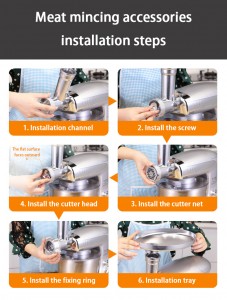A stand mixer has become an essential kitchen appliance for many home bakers. It handles a variety of tasks effortlessly, including mixing, whisking and kneading. Kneading bread dough is a critical step in breadmaking as it helps develop gluten, enhance texture and create a perfect loaf. However, the question arises: how long should you knead bread dough in a stand mixer? In this blog, we’ll explore the answer to that question and give you some tips for getting great results.
Understand the process:
Before delving into the duration of kneading, it’s worth understanding the purpose behind the process. Bread dough is kneaded primarily to create gluten, which gives bread its structure and elasticity. As the dough is mixed and manipulated, the gluten molecules arrange and form a network that traps air bubbles created by yeast fermentation. This development creates a structure that traps gases and expands during baking, resulting in a light and airy loaf.
Factors affecting kneading time:
The amount of time it takes to knead bread dough in a stand mixer can vary depending on a number of factors. These factors include the type of bread you’re making, the recipe you’re following, and the power and capabilities of your stand mixer. Certain bread recipes may require more or less kneading time depending on their specific ingredients and desired texture. It is crucial to read the recipe thoroughly and adjust the kneading time accordingly.
General guidelines:
While there’s no one-size-fits-all answer to the ideal kneading time, there are some general guidelines you can follow. For most bread recipes, 8-10 minutes of kneading the dough in a stand mixer is sufficient. This duration allows enough time for the gluten to develop without risking over-kneading, which can result in a dense and gritty texture. However, it is crucial to monitor the consistency of the dough and adjust accordingly. Additional kneading time may be needed if it feels too sticky and won’t hold together.
Visual and tactile cues:
In addition to following general guidelines, visual and tactile cues can help determine if bread dough is well kneaded. When using a stand mixer, pay attention to how the dough forms and behaves. Initially, the dough will be sticky and puffy, but as the gluten develops, it should become smoother, forming a sticky ball that pulls away from the sides of the bowl. Also, having a “window pane test” can help assess gluten development. Take a small piece of dough and stretch it lightly to see if a thin translucent film is formed that is not easy to tear. If so, your dough is probably ready.
Experiment and adapt:
While timing guides and visual cues can be helpful, it’s important to remember that each bread recipe and stand mixer may require slight adjustments. Become familiar with the capabilities of your particular stand mixer and experiment with different doughs to achieve desired results. With practice, you’ll get a better idea of how your dough should look and feel, ensuring consistent, high-quality bread every time.
Kneading bread dough in a stand mixer is a crucial step in baking delicious homemade bread. While ideal kneading times can vary based on a number of factors, most bread recipes can be well kneaded in a stand mixer in 8-10 minutes. Pay attention to visual and tactile cues of the dough, such as smoothness and dough consistency, to ensure gluten formation. With practice and experience, you’ll become adept at determining the perfect kneading time for consistently delicious homemade bread.
Post time: Aug-02-2023

